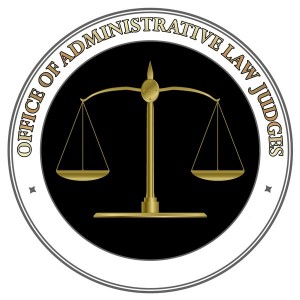Administrative law judges
So last week The Legal Genealogist took on the question of the Magistrate Judge — that federal judicial officer appointed by the trial judges of each United States District Court to assist them in carrying out their responsibilities.1
And that prompted my friend Craig to ask about another kind of judge. “So, where do administrative judges fit into the system?” he asked, noting that he had the impression that “they were also part of the District Court System.”
 Good question, and one that a lot of genealogists may encounter when dealing with their families’ post-World War II encounters with the federal government.
Good question, and one that a lot of genealogists may encounter when dealing with their families’ post-World War II encounters with the federal government.
The fact is, administrative law judges are not exactly judges at all, in the sense of belonging to the Judicial Branch of government. As their name suggests, they work for administrative agencies — the Executive Branch of government — to rule on cases that are being decided by those agencies. An example would be an application for Social Security disability benefits, or whether a developer can get a permit from an environmental protection agency.
Administrative agencies, both at the federal and state levels, have a lot of authority in two different areas. First, they’re given the authority to make rules and regulations. That’s called their rule-making authority. When the IRS interprets the federal income tax code and passes a rule saying you have to file this form instead of that form, that’s rulemaking.2
But second, they also have to pass on a lot of issues where somebody either wants permission to do something or to get a benefit or not to suffer a detriment, and the issue ends up being contested. Because the agency itself has the expertise in that field, the law usually says the matter has to be decided first by the agency itself before anybody can go scurrying off into the courts.
And that internal decision-making is called the agency’s adjudicative authority.3
But who, within the agency, is going to make the decision?
Before 1946, it was always somebody chosen by, hired by and paid by the agency itself — with predictable results. What the agency wanted was just about inevitably what the agency got. The process wasn’t standard from agency to agency, and fairness wasn’t a word most people tended to use in describing what happened.
Enter the administrative law judge system.
It wasn’t called that when it started back in 1946, when the federal Administrative Procedures Act was first passed.4 The first-level administrative decision-makers created by that statute were called examiners,5 or hearing examiners. It wasn’t until 1978 that the name was changed to administrative law judge.6
And in that 1946 statute, two huge changes were made: first, all agencies had to follow a uniform set of procedures in their decision-making; and, second, hearing examiners had to be impartial.7
Administrative Law Judges, or ALJs, in the federal system have to meet certain minimum criteria, including at least seven years of experience as lawyers handling litigated matters,8 and they’re initially screened not by the various agencies but by the federal Office of Personnel Management (OPM).9
Any agency wanting to hire an ALJ gets a list of the three top-rated applicants from OPM and can then choose one of those three. The system isn’t perfect, and the American Bar Association has recommended tightening the requirements and making the entire selection process more independent and more merit-based.10
There is a review system for decisions of the ALJs. First the agency itself has a chance to overturn the decision and then, by statute in most cases, a dissatisfied party can challenga an administrative decision in the federal courts.
But if cousin Ralph worked as a federal hearing examiner in 1960, what he did was serve as an administrative law judge. And if Aunt Mabel was awarded Social Security disability benefits in 1982, or Uncle Charlie got into trouble with his tugboat captain’s license and had to fight to keep it in 1955, chances are the person who made the initial decision was an administrative law judge.
SOURCES
- Judy G. Russell, “The Magistrate Judge,” The Legal Genealogist, posted 22 Mar 2013 (https://www.legalgenealogist.com/blog : accessed 28 Mar 2013). ↩
- See generally 5 U.S.C. § 551, defining a “rule” as “an agency statement of general or particular applicability and future effect designed to implement, interpret, or prescribe law or policy” and rulemaking as the “process for formulating, amending, or repealing a rule.” ↩
- See ibid., defining “adjudication” as the “process for the formulation of an order” and an “order” as a “final disposition … of an agency in a matter other than rule making but including licensing.” ↩
- Administrative Procedure Act, 60 Stat. 237 (11 June 1946). ↩
- See ibid., § 7. ↩
- P.L. 95-251, 92 Stat. 183 (1978). ↩
- Vanessa Burrows, “Administrative Law Judges: An Overview,” Congressional Research Service, April 2010; PDF version online. ↩
- See “Qualification Standard For Administrative Law Judge Positions,” Office of Personnel Management, OPM.gov (http://www.opm.gov : accessed 28 Mar 2013). ↩
- See “Administrative Law Judges,” Office of Personnel Management, OPM.gov (http://www.opm.gov : accessed 28 Mar 2013). ↩
- See American Bar Association, recommendation adopted August 2005, ABAnet.org (http://www.abanet.org/ : accessed 28 Mar 2013). ↩


